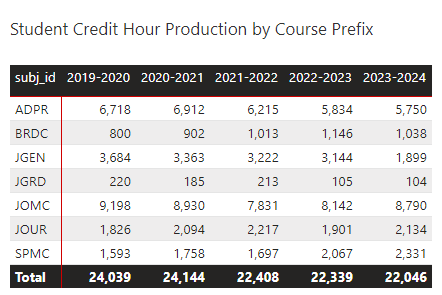Student credit hour (SCH) production serves as a key measure of productivity and impact for the college. It reflects the number of students enrolled in our classes and directly correlates with the tuition revenue generated for the institution. Beyond financial implications, SCH production is a critical metric used by the university to assess the overall health and vitality of academic units. By tracking SCH production over time, we gain valuable insights into trends in enrollment, course demand, and our ability to meet the educational needs of our students.
Before analyzing the data on SCH production, it is essential to consider the broader context by examining university-level trends. This provides critical insights into factors influencing our performance and helps frame the challenges and opportunities we face as a college. To provide a consistent and relevant perspective, this report focuses on a five-year time frame, aligning with the interval most recently used by university leadership to evaluate unit performance. This approach enables us to assess our progress within the framework of institutional expectations and benchmarks.

Across the Lincoln campus, UNL’s SCH production declined from 645,922 in AY 2019-2020 to 619,625 in AY 2023-2024, a 4.1% decrease. Engineering saw the most significant growth among academic colleges, increasing SCH production by 16,333 credit hours, while Arts & Sciences experienced the most significant decline, losing 37,474 SCH.

SCH production declined across all terms, with the summer term experiencing the largest drop—12,301 credit hours, or 2.7%.
SCH Trends in the College of Journalism and Mass Communications
The College of Journalism and Mass Communications saw its SCH production decline from 24,039 in AY 2019-2020 to 22,046 in AY 2023-2024, an 8.3% decrease. While this proportional decline exceeds the university-wide average, it is important to note that in smaller units like ours, each student credit hour carries greater weight and has a more pronounced impact on overall metrics.

Drivers of the Decline
Three of the college’s academic programs—Broadcasting (BRDC), Journalism (JOUR), and Sports Media and Communication (SPMC)—experienced increases in SCH production over the past five years. In contrast, four programs—Advertising and Public Relations (ADPR), Journalism General (JGEN), Journalism and Mass Communications (JOMC), and Journalism Graduate (JGRD)—experienced declines.

The most significant decrease occurred in JGEN courses, which fell from 3,684 SCH in AY 2019-2020 to 1,899 in AY 2023-2024—a reduction of 52.7%. JGEN courses, which serve students outside the college, are taught exclusively by temporary instructors. In 2023, university leadership directed the college to reduce temporary instruction costs, leading to the phased elimination of the JGEN program. This process will continue through AY 2025-2026, resulting in an estimated loss of an additional 2,000 SCH.
The decline in JGEN courses accounts for nearly 90% of the college’s total SCH reduction, underscoring the significant impact of this program’s elimination.
Summer Term Declines
SCH production during the summer term fell from 2,098 in AY 2019-2020 to 1,040 in AY 2023-2024, a 50.4% decline. This drop was primarily driven by a reduction of 267 credit hours in JGEN courses and decreases in core required courses, including ADPR 151, ADPR 830, ADPR 843, JOMC 130-series courses, JOMC 486, and JOMC 487.

The college’s summer budget, which operates independently of the academic year budget, was also reduced in FY 2024 as part of a university-wide initiative. The budget decreased by 13%, from $134,621 to $117,499, further constraining summer program offerings.
Changes Across Class Levels

SCH production declined across all class levels except for 200-level courses. SCH production at the 100 level dropped by 1,174 credit hours (13.3%), largely due to reductions in JGEN courses. Modest declines were also observed in JOMC 130 courses. SCH production decreased by 482 credit hours at the graduate level, primarily due to lower enrollment.
In contrast, 200-level SCH production increased, driven by the introduction of JOUR 200A as a required course for all students and growth in the SPMC major, including the addition of SPMC 250.
ACE-Certified Courses
The decline in JGEN courses also affected SCH production from ACE-certified courses. These courses, certified by the university to meet one of 10 required student learning outcomes, saw SCH production fall from 8,697 in AY 2019-2020 to 6,996 in AY 2023-2024, a decline of 1,701 credit hours or 19.6%.
Notably, the decline in JGEN courses (1,785 SCH) exceeded the overall reduction in ACE-certified courses, suggesting growth in ACE offerings outside the JGEN program. This increase was driven by the addition of ACE-certified courses in SPMC, including SPMC 189H, SPMC 250, and SPMC 450.

Future Considerations
As the college evaluates its SCH production and plans for the future, several factors must be considered that could either hinder or enhance our metrics in the coming years.
One factor contributing to a future decline is the continuation of the phased elimination of the JGEN program. This process, scheduled to conclude in AY 2026-2027, is expected to result in an additional reduction of approximately 2,000 credit hours. The elimination of this program will continue to have a significant impact on the college’s overall SCH production.
Conversely, several initiatives hold the potential to increase SCH production. Launching the esports undergraduate certificate in the Fall of 2025 represents a promising opportunity. This ACE-certified program, open to students from various universities, will exclusively feature courses offered by the college. Similarly, introducing the graduate certificate in sports promotion is expected to attract additional students to the college’s programs, thereby boosting enrollment in graduate-level courses.
However, enrollment in these new programs remains challenging to predict. The success of these initiatives will depend on factors such as market demand, effective recruitment strategies, and ongoing program development. The college will need to monitor enrollment trends closely and remain adaptable to maximize the potential impact of these programs.
By addressing the challenges associated with declining SCH production while leveraging growth opportunities, the college can work toward stabilizing and increasing its contributions to the university's academic mission.




